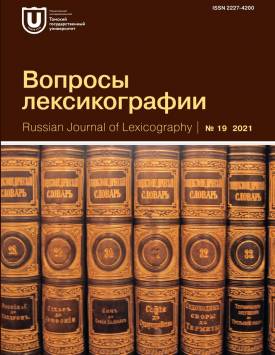On the Problem of Constructing Definitions of Specific Nominal Lexis (Flora and Fauna)
The article discusses two approaches to the dictionary interpretation of specific nominal vocabulary, i.e. logical-rationalistic and psychological. In the traditional approach to the construction of interpretations, which is consistent with the scientific paradigm of structuralism, it is believed that the definition should include only those semantic components that ensure the delimitation of this meaning from the meaning of all other units of the language (E. Bendix); this requirement is fulfilled by creating a definition from a set of necessary and sufficient features. The aim of this article is to find out whether it is possible to construct definitions based on these requirements for groups of specific vocabulary related to flora and fauna, as well as to identify other approaches to the dictionary description of meanings of words of this group. The research material is an array of definitions from 17 explanatory dictionaries of Russian, Ukrainian, Polish, Italian, English, and German. The main research method is semantic and comparative analysis of dictionary definitions. The research has revealed that the interpretation of lexis denoting flora and fauna rarely meet the declared requirements. For example, in the twelve considered definitions of the word linden and its equivalents in other languages, nineteen semantic components are used in total, and their number in different dictionaries ranges from three to eight. None of the interpretations provide an unmistakable recognition of this word and contain a set of necessary and sufficient features. The reason for this phenomenon is due to the fact that names of most biological objects refer to stochastic lexis, which cannot be described through a set of distinguishing features due to the peculiarities of the content of the corresponding concepts. One can find a different approach to the definition of names from flora and fauna groups in practical lexicography. The authors of dictionary definitions rely on the most significant, relevant features of the class of realias, i.e. form an interpretation of those characteristics that often fall into the focus of attention of the ordinary native speaker. In many cases the definition includes those signs of realias that are significant for the national cultural tradition. Thus, in constructing definitions of specific lexis from the group of biological objects, practical lexicography is based on a psychological, rather than logical-rationalistic, approach to the dictionary definition, which is consistent with the new cognitive paradigm in linguistics.
Keywords
lexical meaning, definition, stochastism, psycholinguistic meaning, relevant featureAuthors
| Name | Organization | |
| Zhuikova Marharyta V. | Lesya Ukrainka Volyn National University | mzhujkova@ukr.net |
| Yodlovska Alina I. | Lesya Ukrainka Volyn National University | alino4ka02.03@ukr.net |
References

On the Problem of Constructing Definitions of Specific Nominal Lexis (Flora and Fauna) | Voprosy leksikografii – Russian Journal of Lexicography. 2021. № 19. DOI: 10.17223/22274200/19/3
